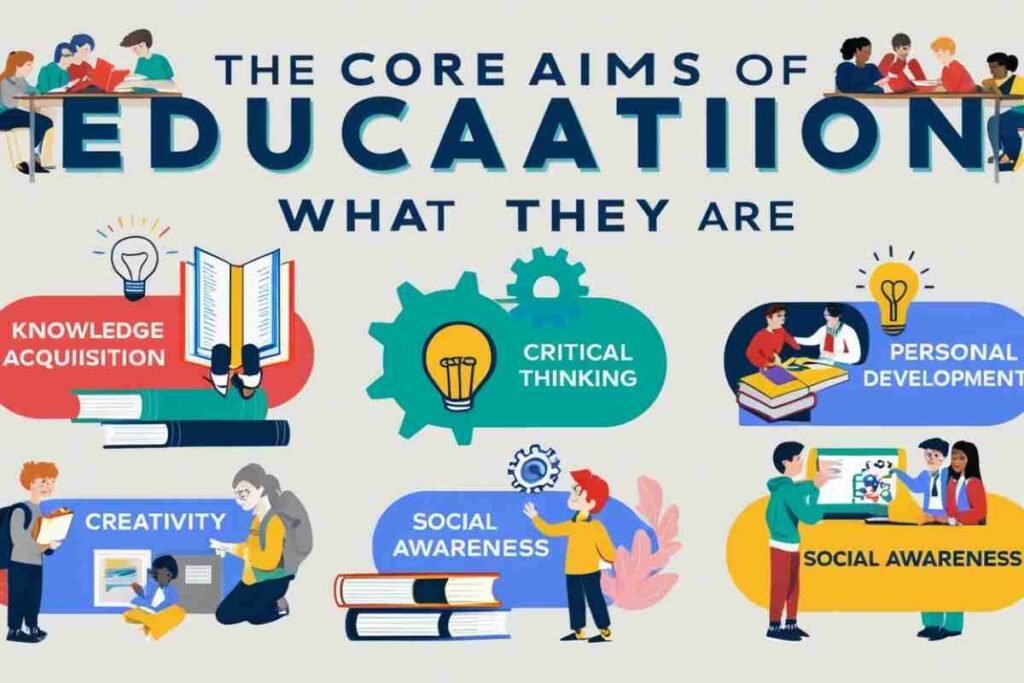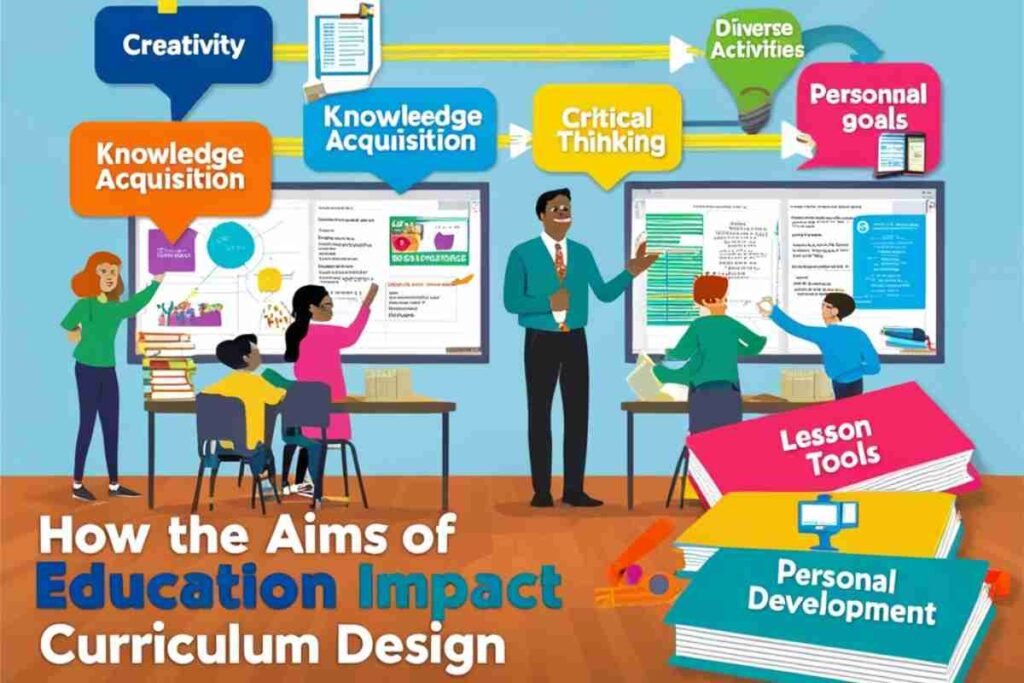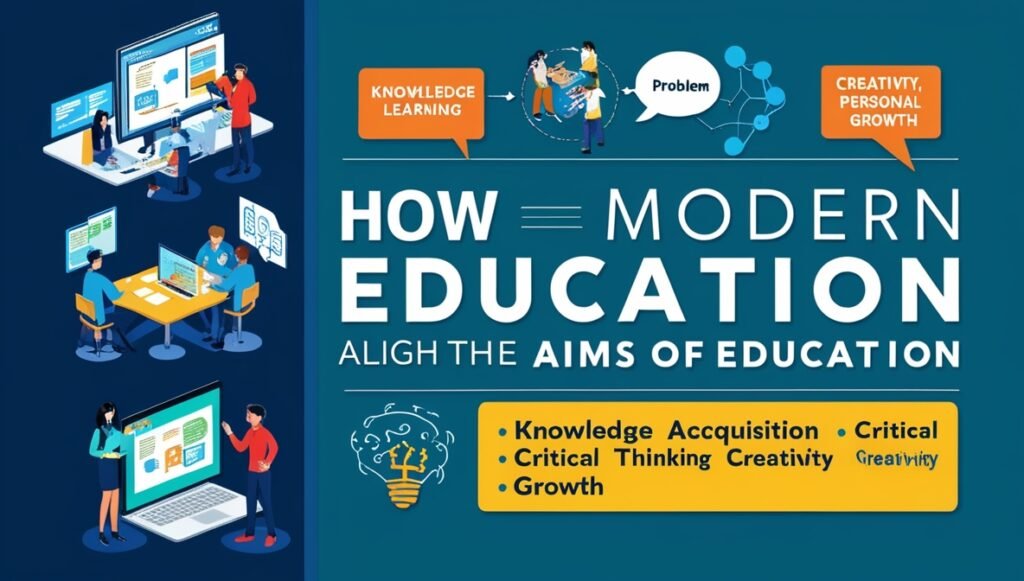Education is one of the most important aspects of human growth. The aims of education provide the foundation for how students learn, develop, and succeed. Education is the process of facilitating learning, or the acquisition of knowledge, skills, values, beliefs, and habits.
These goals not only guide the educational system but also ensure that teaching methods are effective. Understanding the primary aims of education is crucial for both educators and students.
In this article, we’ll explore the most essential goals of education and how they influence teaching strategies worldwide.
The Core Aims of Education: What They Are

At its core, the aims of education are about equipping students with the knowledge and skills they need to succeed in life.
The primary goal is to ensure a well-rounded development of every child, including their intellectual, physical, emotional, and moral growth.
These aims are essential to creating an education system that caters to the individual needs of students while preparing them for the real world.
Here are the core aims:
- Intellectual Development: This is the first and most obvious aim. Education helps develop the cognitive abilities of students, enabling them to think critically, analyze information, and solve problems.
- Physical Development: Education also emphasizes physical fitness and health. Through activities like sports, physical education, and even healthy lifestyle education, students learn the importance of maintaining their bodies for overall well-being.
- Moral Development: Students are taught ethical values and principles that shape their character. This helps them become responsible citizens in society. It is crucial that education includes moral teachings so that students are guided to make ethical decisions, showing respect for others.
- Social Development: Education fosters social skills, enabling students to work in teams, communicate effectively, and build relationships with others. Learning to collaborate and understand different perspectives is essential in a globalized world.
The Role of Teachers in Achieving Educational Aims
Teachers play a central role in achieving the aims of education. Their responsibility is not just to deliver content, but to create an environment that promotes overall growth.
Educators must be equipped with the necessary skills and strategies to guide students toward their goals. Here’s how teachers contribute to these educational aims:
- Creating a Supportive Environment: Teachers should foster a positive classroom culture that encourages learning, curiosity, and personal growth. A supportive environment enables students to feel safe and confident in their abilities.
- Encouraging Critical Thinking: Teachers promote inquiry and problem-solving skills by encouraging students to ask questions and think for themselves. By incorporating open-ended questions and creative assignments, teachers help develop the intellectual capabilities of their students.
- Fostering Moral Values: Teachers instill ethical principles that guide students’ decisions and behaviors both inside and outside the classroom. Lessons on ethics, honesty, and empathy prepare students to face challenges with integrity.
How the Aims of Education Impact Curriculum Design

The aims of education have a direct influence on curriculum design. A curriculum that reflects these aims ensures that students are well-prepared for both academic and life challenges.
By embedding the key educational objectives into the curriculum, schools can guarantee that students receive a comprehensive learning experience.
Here’s how these objectives shape curriculum planning:
- Balanced Learning: A well-designed curriculum includes subjects that promote intellectual, physical, and moral development. Subjects like math, science, literature, and history engage students intellectually, while physical education and arts classes contribute to their physical and emotional growth.
- Practical Life Skills: The curriculum integrates real-world skills that students can apply outside of school, such as financial literacy, social studies, and vocational training.
- Inclusivity: The curriculum should accommodate diverse learning needs and ensure equal opportunities for all students. This includes making adjustments for students with disabilities or varying learning styles, as well as integrating global perspectives that reflect the world’s diversity.
The Importance of Lifelong Learning as an Aim of Education
One of the long-term goals of education is to instill a love for learning. Lifelong learning is a vital aim that ensures students continue to grow intellectually throughout their lives.
Lifelong learning is important for several reasons:
- Adaptability: In a fast-changing world, the ability to learn continuously is essential for adapting to new challenges. Lifelong learning encourages individuals to keep pace with technological advancements and global changes.
- Self-Improvement: Lifelong learning encourages individuals to seek self-development, whether through formal education or personal interests. It helps people stay competitive in the job market, offering opportunities for career advancement.
- Social Contribution: People who embrace lifelong learning are better equipped to contribute positively to their communities. By continuing to gain knowledge and skills, they can offer valuable insights, solve problems, and drive innovation.
How Modern Education Aligns with the Aims of Education

Today’s educational system strives to align with the traditional aims of education while incorporating new approaches and technologies. By integrating the aims of education with modern methodologies, schools can offer more dynamic learning experiences. For example:
- Technology in Education: Technology has transformed how we teach and learn. Virtual classrooms, online resources, and digital tools help achieve the aims of education by making learning more accessible and engaging.
- Inclusive Education: Modern educational policies focus on inclusive practices, ensuring that children with disabilities and diverse backgrounds receive equal educational opportunities.
Conclusion
The aims of education serve as the guiding principles for the development of a student’s mind, body, and character. Achieving these goals requires collaboration between teachers, students, parents, and policymakers.
By focusing on intellectual, physical, moral, and social development, education systems can provide a well-rounded education that prepares students for a successful future.
Ultimately, the success of an education system depends on its ability to adapt and evolve while staying true to its core aims.
FAQs
What are the main aims of education?
The main aims of education are to develop the intellectual, physical, moral, and social abilities of students, ensuring they are well-rounded individuals capable of succeeding in life.
Why is intellectual development an important aim of education?
Intellectual development helps students develop critical thinking, problem-solving skills, and the ability to acquire and apply knowledge effectively in different situations.
How does education contribute to moral development?
Education teaches students ethical values and principles that shape their character, helping them become responsible citizens and make ethical decisions.
What is the importance of physical development in education?
Physical development ensures that students maintain a healthy lifestyle, learn the value of fitness, and engage in physical activities that enhance their well-being.
What role do teachers play in achieving the aims of education?
Teachers create a supportive learning environment, encourage critical thinking, and foster moral values, which helps students achieve the various aims of education.
How does the curriculum reflect the aims of education?
A curriculum that aligns with the aims of education includes subjects and activities that promote intellectual, physical, and moral development, ensuring a balanced approach to learning.
What is the concept of lifelong learning in education?
Lifelong learning is the idea that education should continue beyond formal schooling, encouraging individuals to keep learning throughout their lives to adapt and grow.
How does modern education align with the traditional aims of education?
Modern education incorporates technology, inclusive practices, and dynamic learning methods to meet the traditional aims of education, ensuring a more engaging and accessible learning experience.